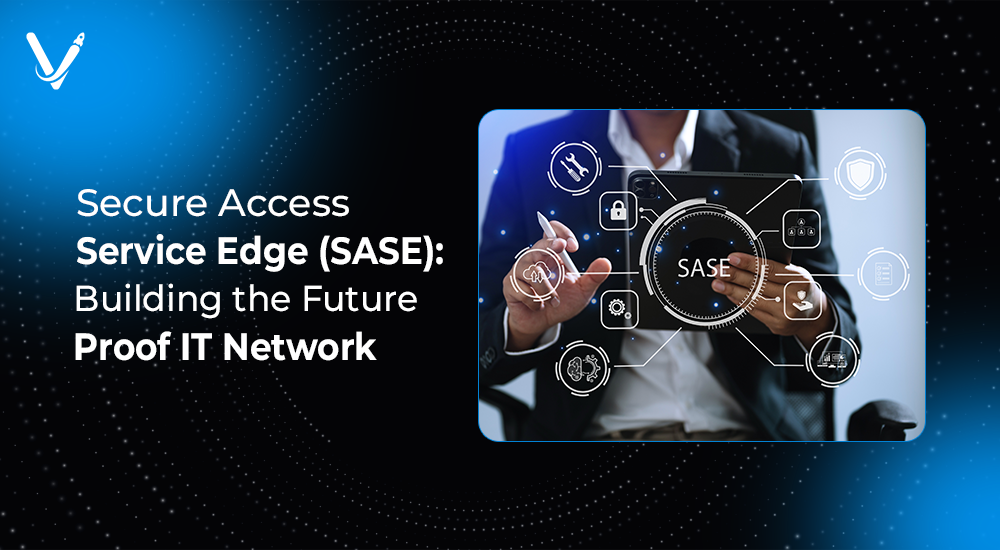Secure Access Service Edge (SASE): Building the Future-Proof IT Network


- Jul 6, 2025



Digital-first businesses now face a paradox: employees need fast, reliable access everywhere, while security threats grow smarter each day. Traditional perimeter-based security can no longer keep up. Enter SASE Secure Access Service Edge, the architecture reshaping how companies think about network security and performance.
SASE technology merges networking and security functions into a cloud-delivered service. It enables secure, fast, and seamless access for users, devices, and applications, regardless of location.
If your organization is scaling remote work, cloud applications, or zero-trust initiatives, understanding SASE is crucial to building a future-proof IT network.
Secure Access Service Edge (SASE) is a cloud-native architecture that integrates WAN capabilities with comprehensive security functions. Instead of relying on data center-centric security appliances, SASE moves these functions to the cloud edge, closer to users and devices.
Core components of what is SASE architecture include:
All these are unified under a single policy framework, leveraging identity, device posture, and real-time risk context to grant access.
A SASE network shifts traffic inspection and security enforcement to the cloud edge rather than backhauling it to a centralized data center. This results in:
For example, when a remote employee connects to a SaaS application, the request routes to the nearest SASE edge location, where SASE cybersecurity services inspect and secure the traffic, providing access based on identity, device, and policy compliance.
Legacy networks relied on MPLS circuits and on-premises firewalls, designed for office-based workforces. Today, the shift to:
has rendered traditional models inadequate.
SASE technology delivers:
Gartner predicts that by 2025, at least 60% of enterprises will have explicit strategies and timelines for SASE adoption.
Implementing SASE Secure Access Service Edge offers numerous advantages:
Improved User Experience
Enhanced Security Posture
Cost Optimization
Simplified IT Operations
Agility and Scalability
A Global Retail Chain
A global retailer with over 800 stores needed to:
By partnering with a secure access service edge solutions company, they replaced their MPLS circuits with SD-WAN, added ZTNA for remote administrators, and enforced SWG and CASB for cloud applications.
Outcomes:
This case showcases SASE implementation as a scalable, secure, and cost-effective modernization strategy.
SASE security is rooted in the zero-trust philosophy: never trust, always verify. Every access request is evaluated based on:
Policies dynamically adjust to threats in real time, reducing exposure. Unlike fragmented legacy solutions, SASE architecture unifies:
under a single framework for consistent, simplified enforcement.
The SASE framework is built on:
Identity-Driven Access: Access decisions depend on the user’s identity, not their network location.
Cloud-Native Design: Built for scalability, resilience, and agility.
Globally Distributed Edge: Inspection and enforcement occur at the edge, minimizing latency.
Integrated Security Services: Firewall, SWG, ZTNA, CASB, and more under one umbrella.
Continuous Risk Assessment: Adjusts policies based on real-time threat intelligence and user behavior.
Organizations implementing the SASE framework achieve:
Here is a structured SASE adoption guide to future-proof your IT network:
Assess Your Current State
Define Goals
Choose the Right SASE Services
Look for SASE products that align with your needs, such as:
Pilot and Test
Begin with a small location or user group to validate performance and security posture.
Full Rollout
Gradually transition branch offices, remote workers, and cloud workloads into the SASE framework.
Continuous Monitoring
Use analytics and threat intelligence to refine policies and optimize performance.
SASE cybersecurity is critical in:
The best SASE solution for unified access should:
Selecting a secure access service edge solutions company with proven deployment expertise and 24/7 support is crucial for seamless transition and optimized outcomes.
Top SASE companies offering advanced SASE products include:
Evaluate these vendors based on:
SASE secure access service edge will evolve to include:
Organizations adopting SASE solutions today will be well-positioned to leverage these advancements for robust, adaptive security.
Practical steps for a smoother SASE transition:
The shift toward cloud-first and remote-friendly operations demands a future-proof, secure, scalable network infrastructure. SASE Secure Access Service Edge offers an effective path forward by merging security and networking into a single, cloud-delivered service.
It enables businesses to:
Vasundhara Infotech specializes in SASE implementation, helping businesses transform their networks for a secure, agile future.
Ready to build your future-proof IT network with SASE? Contact us today to begin your secure network transformation journey.
Copyright © 2025 Vasundhara Infotech. All Rights Reserved.